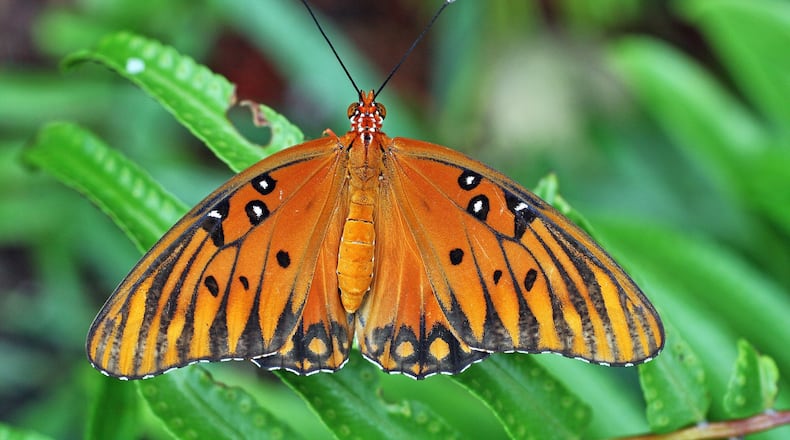During the weekly Nature Ramble at the State Botanical Garden in Athens last week, we paused to examine a sprawling purple passion-flower vine on a fence. Now blooming across Georgia, the passion-flower, or may-pop, is one of the state‘s most beautiful, eye-catching wildflowers.
We were paying more attention, though, to the vine’s bright green leaves, looking for the orangish-colored caterpillars of the Gulf fritillary butterfly. The caterpillars we found were tiny, apparently newly-hatched.
During the next few days, they will feed voraciously on the foliage (if they can avoid predators) until they are large enough to form chrysalises, from which the adult orange-and-black fritillary butterflies will emerge.
You won’t find Gulf fritillary caterpillars on any other plant except the passion-flower, the butterfly’s “host plant.” If there were no passion-flowers, there would be no Gulf fritillaries.
The caterpillars of numerous other species of butterflies and their close cousins, the moths, have similar bonds with specific plants. Monarch butterfly caterpillars, for instance, eat only milkweed plants; zebra swallowtail caterpillars eat only foliage of pawpaw trees.
Some butterflies are named for their host plants. The pipevine swallowtail’s caterpillars feed (no surprise) on pipevine; emperor hackberry caterpillars feed on hackberry. The Gulf fritiallary has even been called passion butterfly because of its preference.
When laying eggs, a female butterfly detects her host plant by landing on a leaf and tasting it with her feet, where her taste receptors are located. If the eggs are laid on the wrong plant, the caterpillars that hatch won’t survive.
For a list of other Georgia butterflies and their host plants, go to: https://georgiawildlife.com/caterpillarfood.
IN THE SKY: From David Dundee, Tellus Science Museum astronomer: The moon will be full on Wednesday — the “Green Corn Moon,” as the Cherokee people called June’s full moon. Venus is in the west at dusk and sets about two hours later. Mars rises in the east just before midnight. Jupiter is high in the east at dusk and will appear near the moon tonight. Saturn rises in the east just before dark and will appear near the moon on Wednesday night.
About the Author
Keep Reading
The Latest
Featured


